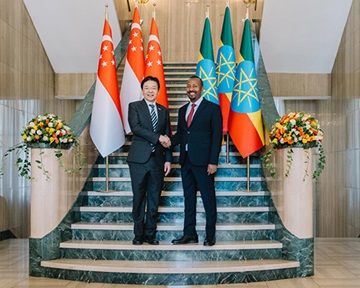Korea and China roll out energy storage facilities in South Africa
Twin battery storage projects to relieve pressure on the strained national electricity grid

In the midst of frequent power outages which has crippled manufacturing and left households without electricity for up to eight hours a day, work has begun on a US$624m Battery Energy Storage System (BESS) programme which aims to alleviate strain on the national grid during peak demand. The first phase of the BESS scheme, which involves the installation of 199 MW of battery storage capacity is being carried out by Hyosung Heavy Industries of South Korea. Located in the KwaZulu-Natal province, the Elandskop facility is expected to take up to a year to complete, and will have enough to power a small town for four hours.
The first phase of the BESS scheme involves the installation of 199 MW of storage capacity, equivalent to 833 MWh, in proximity to eight existing or upcoming renewable energy sites across the country. Eskom awarded 5-year contracts for the design, supply, installation, and maintenance of these battery storage solutions to Hyosung Heavy Industries and its Chinese competitor Pinggao Group. In addition to the Elandskop site, Hyosung also landed contracts for the 40 MW Pongola project in KwaZulu-Natal and the 20 MW Hex site in the Western Cape. Pinggao received contracts for the 80 MW Skaapvlei, 9.5 MW Paleisheuwel, and 5 MW Graafwater sites in the Western Cape.
Phase two of the programme involves installing an additional 144 MW of storage capacity, totalling 616 MWh. The BESS project is being co-financed by the African Development Bank (AfDB), New Development Bank (NDB), the World Bank, and the Clean Technology Fund.
Battery energy storage systems are used to store excess electricity generated by renewable sources, such as solar or wind, and release it back into the grid during times of high demand. The AfDB highlights that Africa has significant deposits of the minerals used in battery technology, including cobalt, manganese, graphite, silicon, nickel, steel, lithium, and aluminium. This presents an opportunity for the continent to develop value chains for these ‘green minerals’ and potentially manufacture components for storage systems. If successful, Eskom’s BESS project could contribute to the growth of such an industry in Africa.
South Africa has a total installed power generation capacity of about 58 GW, with 44 GW produced by Eskom, primarily from coal-fired power stations. However, frequent breakdowns and unplanned maintenance requirements at various power plants result in actual generation being significantly lower than the installed capacity. Eskom has identified a need for approximately 53 GW of new generation capacity, including wind and solar, by 2032. South Africa's Renewable Energy Independent Power Producer Procurement Program (REIPPPP), launched in 2011, allows private sector companies to develop renewable energy projects and enter into power purchase agreements with Eskom.
References
‘Renewable energy in South Africa’, Deloitte, March 2019
‘South Africa’s power grid is under pressure: the how and the why’, The Conversation, 02 November 2021
‘South Africa - Eskom distributed battery energy storage project - project appraisal report’, African Development Bank, 16 November 2021
‘Pinggao Group wins bid for largest energy storage project in Africa’, Xinhua Silk Road Information Service, 14 June 2022
‘Eskom signs battery contracts with Pinggao and Hyosung as part of R11bn roll-out’, Engineering News, 22 June 2022
‘Eskom appoints service providers for its battery energy storage project’, Eskom, 19 July 2022
‘Eskom’s updated TDP 2022 is projecting a requirement of up to 53GW of renewable energy over the next 10 years’, Eskom, 28 October 2022
‘Construction of Eskom’s first battery energy storage project begins’, Eskom, 03 December 2022
‘How Eskom generates electricity’, Eskom, Accessed 19 December 2022








